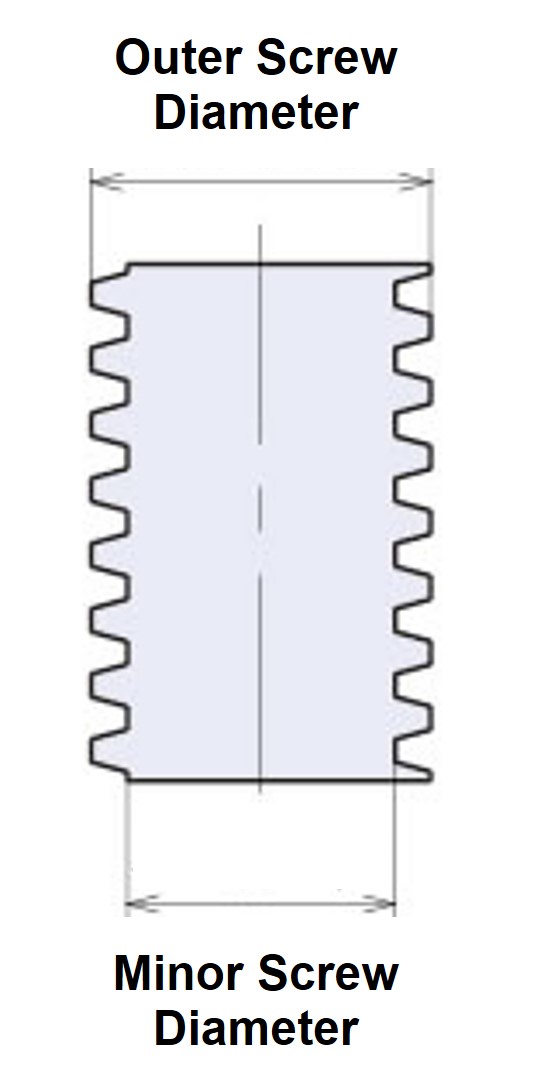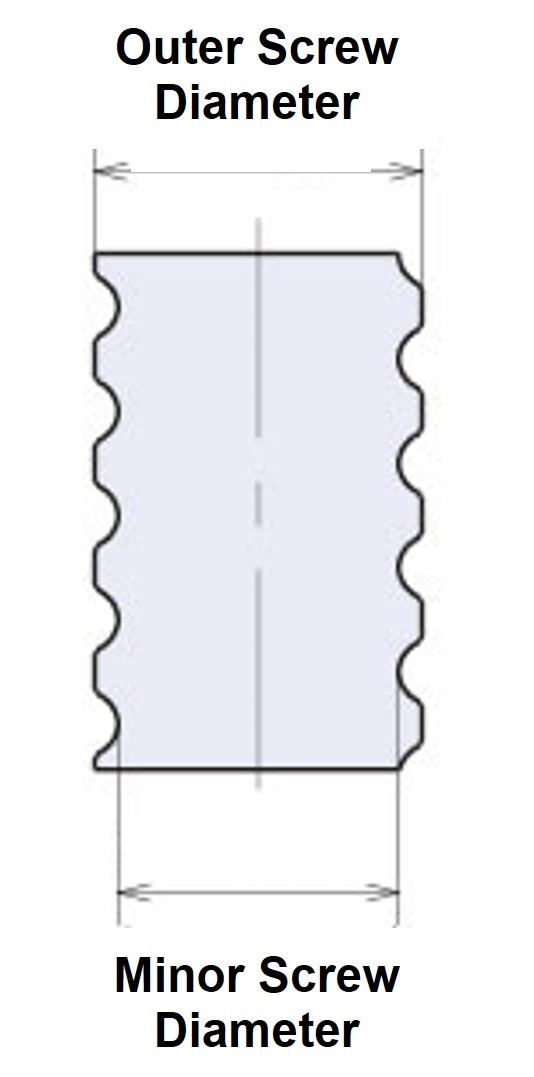Technical Data Linear actuator Linipower Jack Handling
Glossary
1. Basic Capacity :
The maximum possible load sustained or lifted by a jack. However, depending on the nature of the load, it is necessary to select and use a load that includes the service factor (Sf).
2. Screw OD ・Screw Root Dia. :
As illustrated below.

[Trapezoidal Screw ]

[Ball screw ]
3. Screw lead :
For a jack, the amount of axial movement of the screw shaft (or nut in the case of a travel nut type) per revolution of the worm wheel.
4. Stroke :
Distance that the screw shaft (or nut if travel nut type) can be moved.
XMAX-XMIN in dimension drawing
5. Worm Reduction Ratio :
Number of input shaft revolutions required to complete one worm wheel revolution.
(Gear ratio of input shaft and worm wheel )
6. Total Efficiency :
Total efficiency of the jack including those of the screw and the worm wheel.
7. Maximum Allowable Input Capacity :
Allowable input capacity that can regulate the balance between load and screw shaft speed (input rotation speed).
Operate within the rated capacity of duty cycle (%ED) and reducer unit surface temperature (max.80℃).
8. Idling torque without load :
Torque required to rotate the input shaft of an unloaded jack.
9. Holding Torque :
Input torque required for the input shaft when holding the same load as the basic capacity.
10. Allowable Torque on Input Shaft :
Maximum possible torque allowed for input shaft only.
For multiple jack systems, the sum of the torque required for itself and the torque transferred to other jacks to be less than the allowable value.
11. Input Torque Required for Basic Capacity :
Input torque required at the input shaft to lift load of basic capacity.
12. Screw Movement Per Revolution of Input Shaft :
The amount of movement of the screw shaft (or nut in the case of a travel nut type) per revolution of input shaft.
13. Maximum Input Speed for the Basic Capacity :
Maximum possible rpm applied to the input shaft to lift load of basic capacity.
14. Rotational Torque on Screw Shaft at Basic Capacity :
The rotation torque that the screw shaft (or nut in the case of a travel nut type) auto-rotates to lift load of basic capacity.
Rotation prevention must be installed either on the machine or the jack to prevent screw and nut from rotating simultaneously.
15. Allowable load :
The load that can be calculated from the maximum allowable input capacity after the jack's screw shaft speed (input rotation speed) is determined.
16. Buckling :
Because the screw shaft of a jack has a longer shaft length than its cross section, when the compressive force in the screw shaft direction exceeds a certain value, the screw shaft loses stability, resulting in sudden large bending deformation. This is called buckling.
Buckling load varies depending on the support method (installation condition).
17. Allowable screw shaft speed :
The screw shaft rotates under its own weight deflection, and when the rotation speed approaches the natural frequency of the screw shaft, resonance is generated and vibration occurs. Therefore, it must be used at a rotational speed lower than the resonance point (critical rotational speed).
The resonance point is called the allowable screw shaft rotation speed. The jack needs to be considered with a travel nut type in which the screw shaft rotates.
18. Coasting distance :
This indicates a distance from a time when the limit switch or the stop button is operated until the cylinder stops.
This coasting distance varies with load conditions, brake characteristics, and operation circuit.
19. Stopping Precision :
The amount of variation in the stop position when starting and stopping is repeated.
20. Self-Locking :
The ability to maintain load with the jack alone without a brake unit.
All frame numbers 002 to 1000 of JWM (trapezoidal screw type) are self-locking on calculation.
21. Percentage duty cycle :
The duty cycle (also called %ED) is the ratio of run time to total cycle time.
Percentage duty cycle (%ED) = Operation time of one cycle Operation time of one cycle + stop time ×100(%)
22. Generated thrust :
Thrust (maximum lifting load) calculated from the motor rated torque for a single jack with a motor or gear motor.
However, selection is necessary when jacks with drive units are operated in conjunction with other jacks.
23. Ball Screw Wear Life :
The life of a ball screw is determined by flaking of the ball rolling surface due to fatigue and is expressed as the total distance traveled by the screw shaft (nut) before flaking occurs.
This fatigue-induced flaking phenomenon varies within a certain range even when many of the same items are operated under the same conditions.
The life span that can be reached without flaking of 90% or more of the whole is called the rated life (B10 life).

